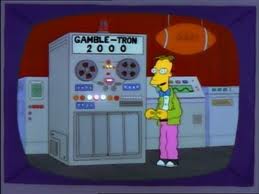One of my all-time favorite movies is Rounders. Matt Damon and Ed Norton talking all smooth and playing poker in cool-looking clubs with John Malkovich spouting repeatable lines in… sort of a Russian accent. Plus, there’s a great Counting Crows song during the credits that I’ve never been able to find anywhere. Anyway, Damon’s Mike McD is the relatively good boy, while Norton’s Worm is the slimier friend.

After Worm gets them beat up with all their cash stolen for having been caught cheating, the gloves come off in an overdue shouting match between the old friends.
Mike McDermott: What the F*** were you thinking?
Worm: I was trying to give us an edge… …I don’t think like that.
Mike McD: No, you don’t THINK!
Worm: No, I don’t think like YOU! You always think you can beat the game straight up. That’s not me. I told you, I’m always gonna look for that edge. Always.
As much as Mike is the better role model, if you’re picking from the two gambling addicts, in fantasy basketball you want to be like Worm. Even if you tried, you can’t cheat in most leagues, but you want to be the one thinking differently, finding your edge. Last week, I mentioned ways to make your league more engaging. From here on out, I’ll give you ways to get an edge in your league by using the numbers to your advantage. These next two weeks leading up to the season, we’ll talk drafting.
My goal here is to not only give you some draft targets based on the data, but to get you thinking about ways you can look for your edge. Maybe you’ll even feel comfortable using some data to customize it to your own situation. If that interests you, I suggest pasting last year’s ESPN Player Rater values into excel and messing around a little. If you get comfortable with that, by the time the season starts, you’ll be better equipped to learn how you can trade a player valued in the 50s, according to what your team needs, for someone with top 20 value to you, because it could be a win/win deal.
Back to drafting, though. Son and Kostas have given you a pair of great stat projections here on Razzball, and you’ve got another set on whatever site you play on (though, a lot of those appear to be created more by algorithms than knowledgeable humans capable of reading news). You’re also probably aware that Yahoo and ESPN provide you with player values in each category relative to the rest of the league. Yahoo has theirs under “std dev” (standard deviations), and ESPN does it on their 8-category Player Rater. Once we get a few weeks into the season, these are very helpful. Until then, and even after that, I’m going to be using a lot of Basketball Monster’s per-game projections, since they also include the type of values I just described. How can we use this to our advantage? Well, instead of just considering Nicolas Batum as the 49th best player (his Yahoo Rank), we’re going to realize that his value is different to each team because he has a distinct value in each of your eight or nine categories (this ain’t fantasy football!). During the draft, each player’s value to each team changes with every single pick that’s made. We not going to get THAT mathy here–

–sorry John Nash. But, just keep that in mind as I show you what I mean.
First up, an exercise in isolating certain categories. The stats that most NBA fans pay attention to are points, rebounds, and assists, so it’ll probably come as no surprise that these are the 12 most valuable fantasy players when looking solely at those three stats on a per-game basis:
Points+Rebounds+Assists
- Russell Westbrook
- James Harden
- LeBron James
- DeMarcus Cousins
- Nikola Jokic
- Anthony Davis
- Karl-Anthony Towns
- John Wall
- Giannis Antetokounmpo
- Blake Griffin
- Kevin Durant
- Damian Lillard
Except for Griffin, these guys are pretty much all ranked in the top 15, so isolating these more obvious stats isn’t really showing you any sneaky-good fantasy targets. But, check out what happens when we do the same thing with the counting stats that far fewer people have memorized (threes, steals, and blocks). Lots of knowledgeable fantasy folks like to look for the “1/1/1 club” guys, but that’s just an arbitrary threshold that leads to overrating that as much as many overrate triple-doubles. Who are the 12 best when you add up just the value of these three categories?
Threes+Steals+Blocks
- Stephen Curry
- Draymond Green
- Joel Embiid
- Giannis Antetokounmpo
- Robert Covington
- DeMarcus Cousins
- James Harden
- Kristaps Porzingis
- Kawhi Leonard
- Russell Westbrook
- Anthony Davis
- John Wall
Now, we’re digging up a few targets. Green, Embiid, and Porzingis are ranked in Yahoo’s 20s, while Covington is all the way down at 60. That’s some great value that might not be quite as obvious to your league-mates. One last version of this exercise, though. These players are the best at two other categories that lots of fantasy managers just ignore. I give you the top 12 at FG% plus FT%, with values weighted for attempts. It’s so hard to stay near the top in both, but it can be done, and these guys can really help (I’ve added a few extras that really jump up with this combination):
FG%+FT%
- Karl-Anthony Towns
- Kevin Durant
- Nikola Jokic
- Kawhi Leonard
- Kyrie Irving
- Enes Kanter
- Danilo Gallinari
- Jonas Valanciunas
- Anthony Davis
- Boban Marjanovic
- Isaiah Thomas
- Chris Paul
18. Clint Capela
19. Marcin Gortat
24. Greg Monroe
25. Dewayne Dedmon
Now, I’m not saying you reach extremely early for the guys above that you don’t normally see in the first few rounds. But, keep them in mind and maybe in your draft queue.
Fun with Punting!

Okay, now the fun really starts. Most of you are probably familiar with punting. In case you’re not, punting is giving up on one category in order to get stronger in multiple categories. The most common category to punt is free throw percentage, since the players that are terrible in that category are often spectacular in many others. In roto leagues, this would mean that instead of expecting to finish in the middle of the pack in FT%, you realize that you could potentially ignore it and lose maybe five points there while gaining something like three points each in FG%, rebounds, and blocks. In head-to-head leagues, it can be even more viable, as you give up on one out of nine categories to give yourself a great chance to win three. Ringer recently wrote a great piece here on Razzball on when and how to successfully implement the punt FT% strategy. Like he said, it’s not something to necessarily plan on, but if the first few rounds fall right, it might be your best option.
Here are the projected worst players for weighted FT% so that you know whose value increases the most if you decide to go this route:
- Andre Drummond
- DeAndre Jordan
- Dwight Howard
- Rudy Gobert
- Jusuf Nurkic
And, the top two are about TWICE as bad as Nurkic. Keep in mind that you should NOT take either of those two if you aren’t punting. Why? Because, if you draft Andre or DeAndre, you’d need about three top 10 guys in weighted FT% just to get your FT% back to average. More likely, though, you’ll end up 2nd worst in FT%, just ahead of the punter, but without the advantages of intentionally punting.
What I like most about punting a category is that you now have a totally different set of rankings than the other teams in your league, and you can take advantage of it. These are players, with their new rankings, that took the biggest leaps, again from Basketball Monster’s per-game projections, when you punt FT% in 8-cat and 9-cat. The bottom line is that these players are more valuable to you than to anyone else in your league.
8-cat FT% Punt
2. LeBron James
9. Rudy Gobert
12. Joel Embiid
17. Andre Drummond
18. DeAndre Jordan
28. Jusuf Nurkic
31. Clint Capela
35. Dwight Howard
42. Lonzo Ball
9-cat FT% Punt
3. Rudy Gobert
10. DeAndre Jordan
12. Andre Drummond
23. Clint Capela
36. Dwight Howard
37. Jusuf Nurkic
38. Nerlens Noel
Based on where these players are being drafted by non-punters, you could probably get almost all of these players on one team. “Great”, you say. “What am I gonna do with six centers? And there aren’t many guards that suck at free throws!” I’m glad you brought up such helpful points. You probably don’t want more than maybe four of those big men. Fortunatley, many of those players also qualify at PF, so you can usually play all those punty guys between your C, PF, and Util spots.

But, here is where the real nerdery begins. As I was deep into the cultivation of my dynasty FT%-punt team, I noticed that I wasn’t maximizing the right stats. I had a surplus in FG%, rebounds, and blocks. I didn’t need to keep hunting only guys that bricked their freebies any longer. I needed guys that filled up the rest of the categories that were still in question. That’s an 8-cat league, so I decided to figure out who ranked near the top when I eliminated the categories that were already decided (FG%, FT%, rebounds, blocks). So, I started focusing on players that make a huge jump when you look solely at points, threes, assists, and steals. Here are the big leapers with their adjusted rankings:
8-cat Points+Threes+Assists+Steals:
8. Kyle Lowry
9. Mike Conley
13. Kemba Walker
14. Ricky Rubio
15. D’Angelo Russell
19. Dennis Schroder
25. Victor Oladipo
28. Lonzo Ball
32. Devin Booker
34. Rajon Rondo
37. Jeremy Lin
39. Markelle Fultz
40. Dennis Smith Jr.
9-cat Points+Threes+Assists+Steals+Turnovers:
6. Mike Conley
8. Kemba Walker
12. Kyle Lowry
13. Bradley Beal
14. Ricky Rubio
18. Gary Harris
21. Victor Oladipo
22. D”Angelo Russell
27. Trevor Ariza
The complete lists are littered with most of the top PGs, so they can actually be early targets for you in a free throw punt, as weird as that may sound. Get to know these guys, punters, because this is who should be rounding out your lineups. Think about what rounds these players go in. You can likely start a team with a star first-round point guard or a big that’s not great at free throws and then take eight or nine of the guys I mentioned in the two lists above, especially once other owners shy away from taking the terrible FT% guys.
You Only THINK You’re Not Punting
This leads me to my last thoughts on the subject of removing categories and such. Most of you aren’t going into drafts planning to punt. You’ll just plan on being well above average in every category, because you know what you’re doing. That’s a great approach, too, but you can still use the concept behind punting to help you during your drafts (and especially in trades, but we’ll talk about that in the coming weeks). For example, say you end up with Jokic, Paul, and Draymond as your first three picks and don’t want to spend the rest of the draft reaching for players that score a lot, because high-scoring players available later don’t tend to do much else. Instead of focusing on one category to the detriment of the others, you might want to think about punting points, as it’s the category we all focus on the most, even if we know we should think of them equally. In this case, being the person that doesn’t focus on it might pay off. Or, maybe you come out of the gate with three 25+ point guys, and you realize you could take it easy on points for a few rounds. Here are your points punt targets with their adjusted rankings:
8-cat Points Punt:
23. Ricky Rubio
30. Robert Covington
33. Al Horford
35. Lonzo Ball
45. Nerlens Noel
48. Elfrid Payon
49. Clint Capela
9-cat Points Punt:
16. Otto Porter Jr.
29. Al Horford
30. Robert Covington
31. Nerlens Noel
33. Ricky Rubio
36. Clint Capela
43. Michael Kidd-Gilchrist
47. Dewayne Dedmon
48. Trevor Ariza
49. Thaddeus Young
Don’t try to chase a category in which you’ve fallen too far behind. You don’t want to be scouring for block specialists with your last three picks, because they’ll likely hurt more than help. And, don’t end up with too much of a surplus in a category that you’re obviously going to win (like 3s if you start with Steph, Kemba, Klay, and Love). Yes, you could plan on loading up on value there and then trading, but would you want to be the guy that needs to trade one of those guys for other stats so much that you have to offer a lopsided deal? Just keep this idea in mind. If you ignore a stat or two, either because you have a surplus or a deficit, you can really add the specific value your team needs. Keep that noggin’ working. You might find this to be the case with assists or FG% or turnovers as your draft pans out, too.
Next week, I’ll go over some more general ways to get an edge in drafts using what I see as market inequities. Zig when they zag, and all that.
Finally, each week, I’ll provide you with an amazing game or season stat line so you can dream about these happening on your fantasy team.
This week’s fantasy line:
Wilt Chamberlain’s 61-62 season: 48.5 mpg/50.4 ppg/25.7 rbg (keeping in mind he also averaged 8.6 assists one season, leading the league in total assists)
*steals and blocks weren’t official stats at that time, but the three games I found from that season with something of a record have Wilt with “at least” 9, 20, and 12 blocks. So, one of those is unofficially a 34/33/20 game.



